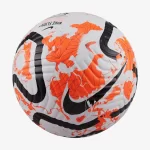Issue 4
Our fourth edition explores reputational challenges faced by a titan of sport, the debate surrounding the Video Assistant Referee and how a new identity and publishing strategy looks to protect the legacy of London’s once most popular newspaper.
Nike runs into trouble
Overview
As the world’s largest sports brand, Nike has long been synonymous with elite performance on and off the track/pitch/court/pavement etc. While its nearest rival, Adidas, has faced numerous challenges over the past few years, most notably with the financial influence and erratic behaviour of one of its most (in)famous brand partners, Nike has revelled in the popularity of some of its most recognisable product lines. Myriad colours and interpretations of its Air Force 1, Dunk models, alongside the globally popular Air Jordan line of shoes that embodies evergreen nostalgia with street cool have kept Nike bubbling away. Until now.
Nike’s recent announcement of its fourth quarter results led to a double-digit tumble in its share price and some strong words of reassurance from its c-suite about how Nike will ‘recover’ from a poorer than expected performance that has led to a walking back of sales predictions for fiscal year 2025, when only three months ago Nike discussed projected growth.
Analysis
Founded by Phil Knight and Bill Bowerman back in the 60’s, Nike is as woven into popular global culture and awareness as Coca-Cola, its reputation continually enhanced by cutting edge sports and leisure products and embellished by elite sport ambassador partnerships over decades. Nike’s marketing has become legend, led by its longstanding agency Wieden+Kennedy who have created a litany of cultural moments linked to sport. Interestingly, I had to track down their ‘Awaken Your Madness’ film online, not having come across it in the press or on socials.
Nike’s share price has been on a downward trajectory over the past few couple of years as it has faced challenges of the Covid tail and its slowing of distribution of product from the Far East, where much of Nike’s shoes and gear is manufactured. Reports of widespread sexism, bullying and toxic workplaces have chipped away at Nike’s previously bulletproof reputation while a 2% reduction in global workforce has shown that the threat posed by lack of innovation has really started to bite.
In witnessing the huge popularity of main competitor Adidas’s Gazelle and Samba line-up (that arguably got too popular when Prime Minister Rishi Sunak and Leader of the Opposition Sir Keir Starmer were seen trying to appropriate the zeitgeisty cool of the German brand) Nike have reacted by announcing a $100 shoe in an effort to steal back market share in that price point, where typically their most popular shoes retail around the $150 mark. A Direct-to-Consumer strategy, sidelining major retailers, has not worked and Nike is seeking to rebuild these important wholesaler relationships as it looks to get back on track.
Verdict
For a $110 billion company with the sporting and cultural kudos that Nike has it might seem forgivable for it to rest on its laurels. But with great power and influence comes great responsibility and while Nike has rinsed and repeated its strategy for success, there are only so many washes gear can take before it shows signs of wear and tear. If I were to point to one particular product line as bellwether for Nike’s popularity, when the concept of ‘running on air’ came to fruition with the launch of Nike Air it heralded a major step forward in sneaker evolution. If Nike Air was exciting, the launch of the Nike Air Max 1 in 1987 with the visible air bubble was seismic. I’d never coveted anything so much in my young life and my sneakerhead journey began in earnest there and then. I’ve owned numerous pairs of Air Max 1, ‘95s and ‘97’s and Air Jordans over the years. However, the latest step in the evolution, the Air Max DN left me cold.
The longstanding insight about consumers’ desire to have sneakers that no one else owns has also been jettisoned in a seeming money grab. Popularity of desirable models such as the Nike Dunk in ‘Panda’ mixed with prolific availability has led to these sneakers becoming ubiquitous and therefore no longer cool, simply because everyone is wearing them. This ‘the same sneakers for everyone’ strategy has allowed relative newcomers such as On and Hoka to steal market share, simply by offering a different look coupled with their own proven and different innovations.
It’s going to take a while for Nike to steer its monstrous super-tanker of a brand in a new direction and back into ‘cooler’ waters again. However, its ability to put its hand up, take note of its failings, manage expectations and take steps to up its game should show that they’re determined to get back to winning ways as fast as possible. Brand success at the sharp end of the UEFA European Football Championships, and at the Olympic Games Paris 2024 should be its re-starting gun.
To VAR or not to VAR? That is the question for the Premier League…
Overview
Ask any Premier League football fan about the use of the Video Assistant Referee, or simply VAR (sounds like pirate-speak) and you’re likely to be met with expletives at worst and frustration at best. Introduced to the Premier League in the 2019-20 season, after numerous in-game trials around the world and with the blessing of the Premier League itself, the ongoing use of VAR has caused such consternation that one Premier League club, Wolverhampton Wanderers, formally requested that it be scrapped altogether. Nonetheless, at the Premier League’s AGM that took place last month, all 20 Premier League clubs in attendance agreed that VAR will continue to be used in the 2024/25 season.
Analysis
The main concerns with VAR voiced by pundits and the football-watching public alike have been the inconsistency in its decision-making week to week, and how VAR removes the raw elation of celebration when a significant occurrence e.g. a last-minute winner or penalty decision given on the pitch, but then requires a wait that seems like hours for whether it was legitimate or not. In terms of the inconsistency, these frustrations are also pointed towards refereeing when one week a penalty is given for an offence and the following week the exact same ‘offence’ is waved away. There is also a lack of communication between the decision-making process and the views exchanged between VAR team and referee and the fans in the stadium. Only in analysis on shows like ‘the world’s most famous football programme’, BBC’s Match of the Day, are fans privy to what was said at the crucial moment long after they’ve left the ground.
In the countdown to the decision, it emerged that one possible significant change to VAR is for fans to be able to hear the conversations between referee and the VAR team during the pitch-side review process. Currently, these conversations are ‘private’, creating a disconnect with the fans in the ground who are suddenly alienated from what they have just witnessed.
Following the AGM, the Premier League has outlined its plans for improving VAR in 2024/25, aiming to accelerate decision-making to keep the game flowing smoothly and to remove the atmosphere-stifling pauses that dogged last season. Interestingly, one of the nine improvement points outlined (Increasing transparency and communication around VAR – including expanded communications from Premier League Match Centre and through broadcast programming such as “Match Officials Mic’d Up”) covers the use of referee microphones so that spectators can be privy in real-time.
Verdict
While VAR has its drawbacks, most notably the threat of subjectivity and human error, it also offers significant benefits in accuracy and fairness. In the main, it works and works well.
From a strictly communications perspective, refining the implementation of VAR by bringing fans into the decision conversation could address the disconnection and forge greater empathy with the referee and the decision he or she is making in real-time. This tactic could also go some way to underline the role the referee plays and protect him/her from the increasing bile and personal attacks they face, especially when fans in the ground don’t like or agree with their decision.
International rugby has mic’d up its referees for years while as far back as 11 years ago it was suggested that microphones on football refs could lead to better behaviour by footballers.
It remains to be seen how mic technology could be implemented in the Premier League and hopefully the summer break will give time and space for a correct approach to be explored. The UEFA European Football Championships 2024 has listed VAR as one of several technologies in place throughout the tournament and could well provide further insights to inform best practice here in England.
In conclusion, the proposal to make referee and VAR conversations audible to fans could be a valuable step towards greater transparency and engagement, ultimately enriching the football experience for everyone involved, on and off the field.
Read all about it…on a weekly basis.
Overview
London’s longest running daily newspaper, the Evening Standard announced recently that it will become a weekly publication. Once a meaty 80-page publication with lots to pore over during the commute to and from work (and if there wasn’t room to read it on a packed tube, a must-read at the kitchen table) the Standard of today has certainly been on the Ozempic. Once priced at 50p, the paper has been a freesheet since 2009, when its owner Evgeny Lebedev’s strategy changed to become advertising revenue focused, leveraging its circulation, reach and influence with the capital’s daily commuting readers to maintain publication.
Analysis
The Evening Standard as it was known used to publish five issues a day, providing the very latest updates to major stories as they unfolded by the hour, from 9/11 and the subsequent Iraq War to the 7/7 bombings and Grenfell tragedy. However, since the pandemic ushered in the whole concept of working from home and with the advent of WiFi throughout London Underground, daily print runs have fallen from 600,000 to 275,000 while the past five years have seen a financial loss of more than £80 million.
As a Londoner born and bred, the Evening Standard has been a constant throughout my life and certainly had a role in my choosing and forging a career as a public relations and reputation consultant. It was the first newspaper that I chose to read independently and I recall feeling quite grown up as I’d flick through it on the Tube, while ES Magazine on a Friday was something I’d relish, treating it as the signal that the weekend had begun in earnest.
The Evening Standard was also the newspaper in which I placed my first ‘big’ story as a young PR executive – an exclusive for my client, Roland Berger, about how the incoming congestion charge’s method of identifying motorists using Automatic Number Plate Recognition was ‘outdated lunacy’. I heard that when my story did finally go off stone and was published on page 2 (Page 1 was for a long period at that time dedicated to the 2nd Iraq war and the aftermath of 9/11), it even featured on the newsstand posters that were then updated with the very latest headlines as the day went on. I still have that issue somewhere in a shoebox.
Verdict
The appointment of Dylan Jones as Editor-in-Chief this time last year signalled wholesale changes and has led to what one could call an ‘upgrade’ to the 200-year-old publication’s look, feel and business model and it seems, so far, to be in good shape for a fair while at least. I look forward to reading the new weekly edition later this year.




